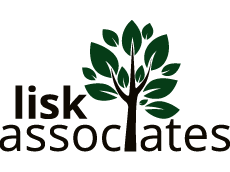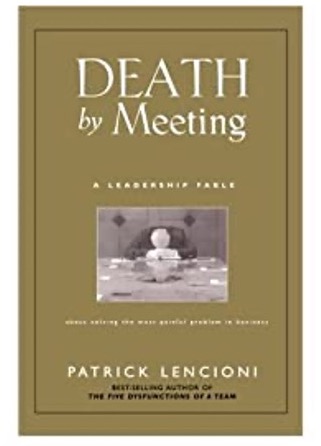Death by Meeting is a 2004 book by Patrick Lencioni. I have adopted this post from his book. I see many similarities between Lencioni and myself. I have most (if not all) of Lencioni’s books on my shelf including The Five Dysfunctions of a Team. I wonder if he has any of the Lisk books on his shelf?
Lencioni calls meetings, “the most painful problem in business”. The meeting has certainly changed over the past 12 months, but his concepts about meetings are timeless. Here are some action items to take your meetings from the most painful problem in business to a competitive advantage.
Lencioni says most meetings are boring and ineffective. They are boring because they lack drama (conflict) and they are ineffective because they lack contextual structure.
Boring usually occurs because your topic lacks drama.
Boring Example #1. Expenses. Using Lencioni’s example from the book, “All right people, we are 12% over budget and from what I can tell we’re spending way too much money on travel. Going forward, we need to have better controls and monitoring to meet the corporate guidelines on the budget.”
Boring Example #2. Remote workers. “All right people, I don’t know about you all, but the fact we don’t have our people back here in the office where we can see each other working is ridiculous, am I right? What do you all think?”
This are examples of “Do-To” where the leader is providing their authoritarian opinion. Neither of these examples encourages anyone to get their brain into the game. One way to overcome boring is to incorporate “a hook”. Here’s what a transition with a hook may sound like.
Example #1 with a hook: “OK everyone, we are here to talk about cutting expenses, which doesn’t sound like much fun. But, consider there are plenty of people out there who have a vested interest in the way we spend our money. And, our competitors are hoping we throw our money around carelessly. Our customers don’t want to pay higher prices. Our families would rather see more money in our paychecks than in our travel budget. So, let’s dig into this issue with a sense of urgency and focus, because I certainly want to make sure that we’re using resources in the way our investors and shareholders intended.”
Example #2 with a hook: “OK everyone, we have all been through a lot in the last year. Our employees have done a great job overcoming adversity, not only professionally but personally. They have kept our ship afloat. We have survived the worst and we have lots to look forward to this year. While we want to be safe and remain a best places to work, it’s time to start looking forward at what opportunities coming back to in-person work could look like. What are you all hearing from your people?”
“Ineffective” occurs because your meetings lack contextual structure. In my view, contextual structure is a fancy way of saying, they lack purpose.
“The Staff Meeting”. Lencioni finds the staff meeting a “catch-all” which could include strategy, administration, tactics, and culture. The attendees don’t know whether they will be brainstorming, debating, voting, weighing in, or just listening. Lencioni refers to this as “Meeting Stew”.
Here’s an example: The leader has set a weekly staff meeting every Wednesday from 09:00-11:00 AM. They have sent out an agenda (which has basically the same order of topics every week) with five topics on it. The meeting starts at 09:00-ish. The first topic takes an hour because everyone knows they are going to be there for two hours so they find something to say. Topic #1 may or may not be the most important topic on the agenda. Topic #2 takes 45 minutes (and the leader got off track talking about something that wasn’t even on the agenda) which now leaves only 15 minutes for the last three topics. And, topic #2 may or may not be the most important topic of the day. The last three topics are rushed and the meeting still let out 20 minutes late. One person is upset the meeting started late and ended late (again). Another was upset they didn’t debate his topic until the very end (but everyone was tired and ready to get out of there). One thought there was too much brainstorming and “pie in the sky”. Another there wasn’t enough brainstorming and too much problem-solving. Finally, one was upset because we still didn’t set a definite date for the company picnic. As Lencioni says, “This may not be exactly like meetings in your organization. But it represents many of the problems that I encounter time and time again.” He’s talking about “meeting stew.”
How to overcome “meeting stew”. Lencioni suggests, “There should be different meetings with different purposes”. Each meeting should provide an important function. I also believe the meetings should meet our “simple. practical. valuable.” criteria. He suggests four different types of meetings.
Meeting #1: The Daily Check-In. Length of time: 5 minutes. This has also been called the daily huddle or the daily stand-up. The purpose of the daily check in is to get everyone focused on doing the right things at the right times and report on the activities they anticipate working on that day. There are two ground rules for this meeting: The first is you keep it to five minutes and the second is you must stand. In addition to those challenges, this meeting is a challenge for remote workers and different time zones. Could this be done on ZOOM? Could the daily check-in be sent in as a video?
Metting #2: The Weekly Tactical. Length of time: 45-90 minutes. The weekly tactical meeting includes three phases: Phase I – The Lightning Round. Each team member reports their top 2-3 priorities for the week. The lightning round is 1 minute per person. In today’s generation, you could call this the “Twitter Round: 140 seconds per person”.
Phase 2: Progeess Reporting. Progress reports is the routine reporting of critical information or metrics. There should be between 3-6 key metrics to report on. Each person’s progress report should be 5 minutes. Questions for clarification are allowed here, but debate and brainstorming should be avoided here.
Phase 3: RealTime Agenda. As the owner of RealTime Coaching you know I like the concept of the RealTIme Agenda. Phase 3 should begin approximately 15 minutes into the meeting. The leader of the meeting must have what Lencioni calls “discipline spontaneity”. The purpose of phase 3 is to invest time talking about the most important tactical decisions we need to make this week. These topics are designed to ensure success on short-term objectives. If you are the leader and are having trouble determining the realtime agenda, you may need to ask a question: What is the #1 problem we need to solve this week?
The challenge with the weekly tactical is discipline. Discipline to not prepare a ready-made agenda. Discipline to not let the lightning round go over time. And, discipline to not go into strategic discussions that deserve more thought and brain-storming vs. decision-making. Strategic conversations will be the primary focus in the next meeting type.
Meeting #3: The Monthly Strategic. Length of time: 3-4 Hours. Lencioni calls these meetings “the most fun”. This meeting is where executives wrestle with, analyze, debate, and decide upon critical issues affecting the business in fundamental ways. The challenges for this meeting are twofold: #1 – Failure to schedule enough time for them. If you only have one issue, schedule for two hours. If you have 4 issues, schedule an entire day. Related to challenge #1 is putting too many items on the agenda. Challenge #3 is failure to prepare. This is an executive team meeting held monthly. The team should know about the topics as soon as possible and begin preparing their point of view vs. “winging it”. The final challenge is “fear of conflict” (one of the five dysfunctions of a team). Team members must be able to openly debate, discuss, and participate in productive business conflict.
Meeting #4: The Quarterly Off-Site Review. Length of time: 1-2 days. An effective off-site provides executives the opportunity to step away from working in the business to working on the business. Lencioni identifies several topics to cover including: Comprehensive Strategy Review, Team Review, Personnel Review, and Competitive/Industry Review. The challenges for these types of meetings include over-structuring the agenda, creating a boondoggle by having it an exotic location, and inviting outsiders to attend as executive team members.
One way to help your off-sites become more productive is by utilizing an outside facilitator. If you would like more help making your meetings more effective, reach out to me and I’d be happy to help. ryan@liskassociates.com


2 replies on “How to Avoid Death By Meeting”
Ineffective meeting: a place where minutes are kept and hours are lost.
Meetings seem to be a hot topic. I just received an e-newsletter on running effective meetings from one of my counterparts: Shawn Kent Hayashi from The Professional Development Group in Pennsylvania. I thought her Leadership Team Meeting Agenda was worth sharing.
Leadership Team Meeting Agenda:
Review norms (rotate every other meeting).
Share good news!
Review accountabilities and scorecard.
Review projects and 90-day priorities on the horizon.
Share customer and employee headlines.
Review opportunities for improvement/issues list.
Invite people to share what they’ve learned recently and what they are practicing now.
Create to-do list / action items for next steps.
Conclude: “On a 10-point scale, how did we do? What needs to happen next time to get a 10?”
Thanks to SKH for sharing.